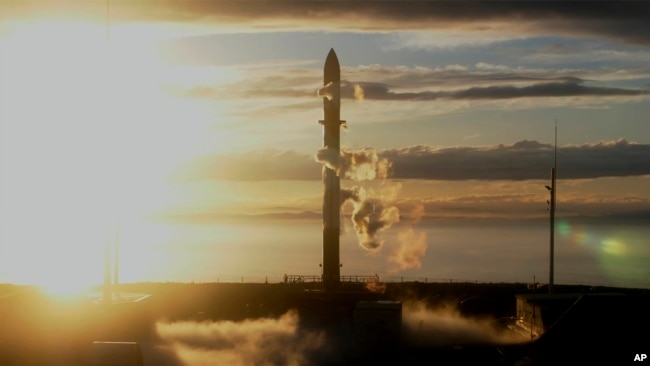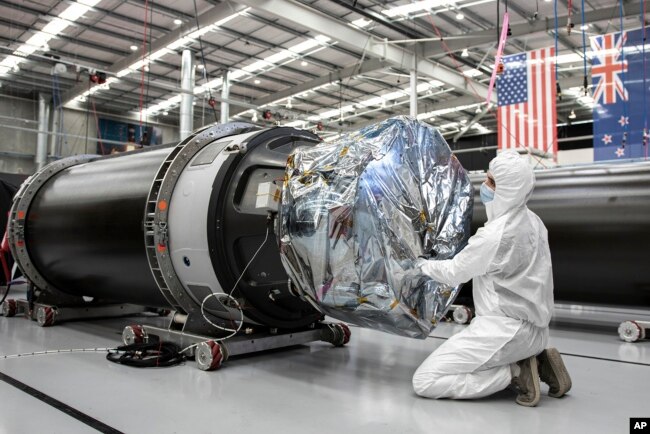NASA,月基地に向けた人工衛星打ち上げ
海の次は、空、宇宙です!!
すでに何回も関連記事を掲載していますので、難なく聴くことが出来ることでしょう!!
Check your vocabulary!!
VOAで英語を学びましょう!!
NASA、月周回軌道を検証する人工衛星を打ち上げ(和訳)
NASA Launches Satellite to Test New Orbit Around Moon
June 30,2022

アメリカの宇宙機関NASAは、月の周りを回る新しいorbit軌道をテストするためのsatellite 人工衛星を打ち上げました。
この人工衛星は、アメリカの宇宙企業Rocket Labロケットラボが製造したロケットで、火曜日、ニュージーランドから打ち上げられました。
この人工衛星はCubeSatキューブサットと呼ばれています。キューブサットは、超小型人工衛星としても知られている小型の研究用宇宙船です。科学者、政府、民間団体が宇宙実験を行うための低コストな方法を提供します。
火曜日に打ち上げられたキューブサットの重さは約25キログラム。この人工衛星は、米国に本拠を置くAdvanced Spaceアドバンスト・スペース社が所有しています。
NASAは、このCubeSatのミッションをCAPSTONEと呼んでいます。この小型衛星は、月の周りを回る新しい経路をとる最初の人工衛星となります。
NASAによると、このミッションはNASAのArtemisアルテミスプログラムの研究をサポートするためのものだと言います。アルテミスは、2025年までにアメリカの宇宙飛行士を月に着陸させることを目標としています。これは、1972年にNASAがアポロ17号を着陸させて以来、人類初の月への訪問となります。
NASAは、CAPSTONEキューブサットの打ち上げがうまくいったと報告しました。人工衛星を軌道に乗せるには4ヶ月以上かかり、3段階に分けて行われる予定です。
今後5日間で、ロケットラボの上段ブースターロケットLunar Photonルナ・フォトンが、キューブサットの軌道を地球からどんどん上げていく予定です。その後、フォトンのエンジンが最後に噴射され、CAPSTONEは地球の軌道を離れ、月へ向かいます。
NASAは声明で、キューブサットは、”その後、CAPSTONEは自身のpropulsion推進力と太陽のgravity 重力を利用して、月までの残りの道のりを航行する”と述べています。このgravity-driven重力駆動の経路により、キューブサットが月へ行くのに必要な燃料の量を大幅に減らすことができると期待されています。
NASAは、CAPSTONEがテストする軌道を”宇宙における重力のスイートスポット”と呼んでいます。この軌道は、"地球と月からの重力が相互作用して、ほぼ安定した軌道を可能にする "点を表しています。
将来、NASAはこの同じ軌道上にGatewayゲートウェイと呼ばれる月宇宙ステーションを建設する計画です。このステーションは、アルテミスプログラムの一環として、宇宙飛行士が月面に移動するための出発点となる可能性があります。
キューブサッとは、少なくとも6ヶ月間、軌道上の活動に関するデータを収集し、地球に送信することが期待されています。
NASA Launches Satellite to Test New Orbit Around Moon
The American space agency NASA has launched a satellite designed to test a new orbit around the moon.
The satellite launched Tuesday from New Zealand on a rocket built by American space company Rocket Lab.
The satellite is called a CubeSat. CubeSats are small research spacecraft also known as nanosatellites. They provide a low-cost way for scientists, governments and private organizations to carry out space experiments.
The CubeSat launched Tuesday weighs about 25 kilograms. The satellite is owned by the U.S.-based company Advanced Space.
NASA is calling its CubeSat mission CAPSTONE. The small satellite will be the first to take a new path around the moon.
NASA said the mission is meant to support research for the agency’s Artemis program. Artemis aims to land American astronauts on the moon by 2025. It would mark the first human visit to the moon since NASA’s Apollo 17 landing in 1972.
NASA reported the launch of the CAPSTONE CubeSat went well. Getting the satellite into orbit will take more than four months and will be done in three stages.
Over the next five days, Rocket Lab’s Lunar Photon upper stage booster rocket is expected to raise the CubeSat’s orbit further and further from Earth. After that, Photon's engines will fire a final time, permitting CAPSTONE to escape Earth's orbit and head for the moon.
The CubeSat “will then use its own propulsion and the sun’s gravity to navigate the rest of the way to the Moon,” NASA said in a statement. This gravity-driven path is expected to greatly reduce the amount of fuel the CubeSat needs to get to the Moon.
NASA calls the orbiting path CAPSTONE will test “a gravitational sweet spot in space.” The path represents a point “where the pull of gravity from Earth and the Moon interact to allow for a nearly-stable orbit.”
In the future, NASA plans to build a lunar space station called Gateway in this same orbital path. The station could be a launching point for astronauts to travel to the moon's surface as part of its Artemis program.
The CubeSat is expected to collect and send data about its orbiting activities back to Earth for at least six months.
Words in This Story
mission – n. an important project or trip, especially involving space travel
stage – n. a period of development, or a particular time in a process
booster – n. an engine on a spacecraft that gives extra power for the first part of a flight
propulsion – n. the force produced by a system for moving, or propelling, a vehicle
navigate – v. to find the right direction for traveling by using maps or other equipment
allow – v. to permit
stable – adj. not likely to change or end suddenly

